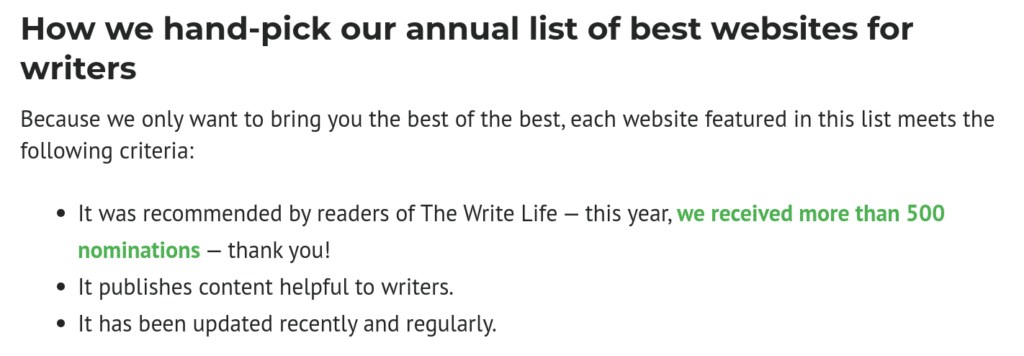This week at The Write Life, we published our 2021 list of Best Websites for Writers.
Publishing this list every year is one of the best things we’ve done to grow the site.
Not only do we tend to have our biggest traffic month of the year when we publish the post in January — last year more than 600,000 pageviews that month — but we also see residual effects throughout the year.

Publishing a “best of” list is one of the oldest tricks in the book when it comes to growing a website, and yet I still recommend it.
Here’s why this strategy works:
When you include lots of people or companies on a list that shows how great they are, they want to tell everyone else. That leads to social shares across the web (more about that below), and more importantly, back-links.
A back-link is another website’s link to your website within their content. Google cares tremendously about back-links, especially when they’re from other high-profile (known as DR, or high Domain Ranking) sites.
We collect lots of back-links after the publication of our annual list, both from those who are included in our list and from others who aren’t on the list but consider it a valuable resource and want to share it with their community.
(Side note: Creating valuable content that gets noticed organically is the best way to get back-links, rather than cold-emailing sites with your content and asking to be inserted into their site. The latter has a low success rate and is incredibly annoying to most recipients, and yet is still practiced widely.)
Those back-links not only help that particular best websites post to rank high in Google results, it also reflects positively on our website generally, which suggests to Google that they should rank our other posts high in search results, too. This is one of the reasons we’ve been so successful with SEO on The Write Life.
If you want others to treat you like an authority, you have to act like an authority. Don’t wait for someone to give you permission. The most respected sites own their authority, which is why readers trust them.
Curating a “best of” list positions you as that authority, for it requires knowledge of the industry to create well. Especially if no one in your industry is doing this already, grab that bull by the horns and be the one to create it.
We first published our best websites list in 2014, a year after launching the brand, and while we’re not the only ones in the industry who publish something like this, we’re arguably the most respected, the list that people in the industry most want to be on.
If someone in your industry is already doing this — which is highly possible, since as I mentioned up top, it’s one of the oldest online tricks for providing massive value to your audience and seeing lots of ROI — don’t give up on the idea. Instead, find a way to create a list with your own unique angle. Or if you think you can do it better than your competitor, go for it.
Posts like this tend to get a lot of shares on social media. Most of those happen when the post is published, so we always see a peak of traffic each January. But shares still trickle in throughout the year, because this is a piece of content that’s highly valuable all year round.
While I personally value short-term traction on social media less than long-term SEO success, this type of sharing blitz has its benefits. It puts the piece in front of more people, who might also share or add their own back-link. And it most certainly adds to the credibility and reputation of the brand.
These posts tend to rank high in search for lots of terms; our 2020 list ranks in position 1 when a reader searches Google for “best writing websites for writers,” which sees a search volume of 100 searches each month.
But at the time when I wrote this post, it only ranked in position 4 for the highest-volume keyword relating to this topic, “writing websites.” I searched using in-cognito mode to see who beats us for that keyword, and the result made me laugh. The featured snippet, which is the top result in Google search below ads, the one that shows an excerpt pulled right from the post, is from our 2019 best websites list.
Typically, when we update a list post, say, for example, this post on writing retreats, we replace the old content with the new content. So if you search for our list of writing retreats, you’ll only find the 2021 list, not the 2020 list or lists for previous years. We replace the old content with the new content and keep the same URL because that’s the best way to get content to rank high in search. Partly because both readers and Google like when content is up-to-date, and also because it prevents cannibalization.
I explain cannibalization and how to combat it in this post on search engine optimization, but the idea is to have only one post that competes for your target keyword. In the case of “writing websites,” we have not one but eight posts competing for that keyword.
We chose not to replace our best websites list each year, and instead to republish each new post at a new URL, because we believe it’s better for the reader. Readers might want to look back at which websites were on the list years ago, or websites that made the list in a certain year might want to keep that historical record.
Sometimes what’s best for the reader isn’t what’s best for SEO, and in cases like this, we side with the reader. But the price to pay here is small; our most recent post isn’t the top search result, but several of our posts from different years show up in the top five results. One way we help readers who land on an old list find the new list is by adding a link to the newest list at the top of every old list.
Thinking about publishing your own “best of” list for your industry?
Here are a few tips and insights for doing it well.
High-quality lists are not quick to put together, so it will take work on your part or money to pay someone else to do it well. The first time you do something is always the hardest, but once you come around the second time, it will be easier and slightly less time-consuming.
All the work for our list this year was done by one of our fantastic writers, Farrah Daniel, and our managing editor, Jessica Lawlor. Farrah hand-picked every website on the list, adding more than 37 newcomers this year, as well as two new categories, Black Voices and Newsletters. She put a lot of work into this, and it shows!
In the content world, the best way to gain trust, social shares and back-links is by creating something that’s more valuable than all the other noise out there. It takes a lot of effort, but it’s worth it.
Figure out how you’ll judge who makes the list, and explain that clearly in your piece. While some of the decision-making process will most certainly be your own judgement, identifying some “must-haves” will help you make decisions and also help the reader trust those decisions.
I learned this for the first time when compiling the “best careers” list for U.S. News & World Report in 2011. (That list no longer exists because they replace it every year with a fresh one, but here are my other USN stories.) There wasn’t a standing methodology in place for choosing the list, so I had to create one and explain it clearly to the readers.
Your methodology can be simple, so long as you have one. Here’s what ours looks like for The Write Life this year:

Screenshot of methodology on The Write Life
“Best” in particular can be tricky, because you’re claiming to choose the top items in that category. While “best” tends to be a popular keyword for search engine optimization, it’s too high of a bar for some pieces.
If you don’t want to put in the effort required to truly identify the “best” of a category, take out the word “best” and make it a list instead, something like this: 55 Incredible Writing Retreats to Attend in 2021. We avoided “best” because we can’t confidently say we didn’t miss a great retreat we don’t know about. Sometimes within the post we’ll write, “these are 55 of the best,” which is a work-around that doesn’t commit us to knowing this industry like the back of our hand.
Once we publish the post, we email everyone on it to let them know. This takes effort, mostly in finding all of those email addresses, but it drastically increases the number of shares and back-links to the post.
If you expect everyone who’s included to notice it on their own, lots of people will miss it. Email them with the link to make sure they see it.
Some marketers suggest asking for a social share when you send the link, but only do this if it feels good to you. If someone is included on a list they respect, they might share it on their own. If you do suggest a share, try to make it easy for them by offering language, so they can easily cut and paste without much brain power.
If Twitter is popular for your industry, you might also take the time to schedule lots of tweets that @mention all the people included on the list, a handful in each tweet. This makes it easy for parties that are mentioned to RT and share with their audience.
When we email folks to let them know they made the list, we send along a badge that says something like, “100 Best Websites for Writers, 2021,” in case they want to add it to their website.
This isn’t as popular as it used to be back in the day, but some bloggers still showcase those badges on their site and link back to the list, which — you guessed it — leads to a back-link. We work with a freelance designer to create the badges so they look professional.
Here’s the badge we offered to winners this year:

Finally, before you create the list each year, ask your audience for recommendations. This provides lots of ideas and gives us insight into which websites our audience is reading, including new sites that have popped up since the last time we published the list.
This request also serves as pre-marketing for the post. Everyone wants to nominate themselves or their favorite sites, and sometimes people who want to make the list share the request with their audience and ask for nominations, which helps the request post gain even more reach.
To show you just how popular this can be, our post asking for nominations for the 2021 best websites list has 545 comments.
It was fun to compile this list, especially looking back at which writer compiled the post each year and how our graphics have improved.
Have questions? I’m happy to answer them in the comments.